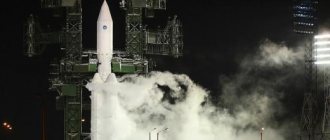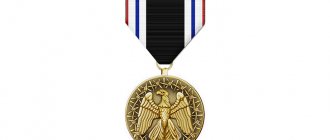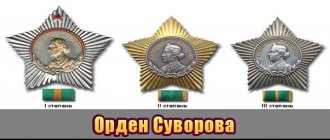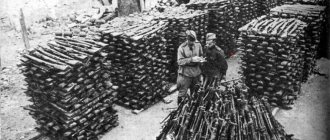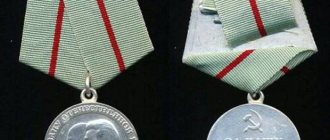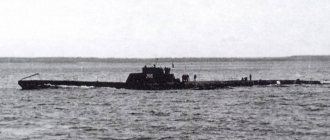The Great Patriotic War became one of the most difficult and tragic pages in our history. On the day of the Great Victory, the medal “For Victory over Germany in the Great Patriotic War of 1941-1945” was established, which became the most widespread military award.
The medal with the image of Joseph Stalin and the words “We won our just cause” appeared as a result of the decree of the Presidium of the Supreme Soviet of the USSR “On the establishment of the medal “For Victory over Germany in the Great Patriotic War of 1941-1945.” And for the first time the need for this award began to be discussed in 1944, when there was no longer any doubt about the victorious end of the war. Among two dozen proposals, a sketch by artists I. Ya. Romanov and I. K. Andrianov was chosen. In addition, it is known that it was planned to produce different types of medals for military personnel, depending on the time spent at the fronts. As a result, this idea was abandoned and the medal became the same for everyone, including the high command.
"We won"
The idea of establishing a medal to commemorate victory in the Great Patriotic War first began to be discussed in October 1944.
The successes of the Soviet troops, as well as the landing of the allies in Normandy, left no doubt that the final defeat of Nazi Germany was not just a settled issue, but a matter of the near future. Article on the topic Heroic history. The first Hero of the USSR was a pilot, and the last - a diver
Despite the fact that no one disputed the need for such a medal, the implementation of the idea was not forced. At the beginning of 1945, about 20 sketches of the award were created. There were even options that provided for different types of medals depending on how long a particular serviceman spent at the front. Nevertheless, in the end they agreed that the reward should be the same for everyone.
The official development of the appearance of the medal began on May 5, 1945, after the Technical Committee of the Main Quartermaster Directorate received the corresponding task from the Chief of Logistics of the Red Army, Army General Khrulev .
On May 9, 1945, by Decree of the Presidium of the Supreme Soviet of the USSR, the medal, whose full name was “For the victory over Germany in the Great Patriotic War of 1941–1945,” was approved in the form proposed by the artists E. Romanov and I. Andrianov .
According to the authors’ idea, the obverse of the medal depicted Stalin’s , as well as the inscription “Our cause is just - we won.” On the reverse side of the medal was stamped its full name.
Military orders and medals of the Soviet Union. Victory medals
Victory in the Great Patriotic War required the issuance of a special medal, which became the medal “For Victory over Germany.” The medal appeared on May 9, 1945, on Victory Day, its full name was “For the victory over Germany in the Great Patriotic War of 1941-1945.” However, the war did not end there; remaining faithful to the agreements reached with the allies, the Soviet Union began a war with Japan on August 9, 1945. Already on September 2, 1945, Japan signed an agreement on unconditional surrender. On September 30, another military medal was established in the USSR - “For Victory over Japan.” Medal "For Victory over Germany"
The medal “For Victory over Germany” became the most common award of the USSR. This was due to the fact that Soviet citizens, both at the front and in the rear, took a massive part in the fight against the Nazi conquerors and the defense of their Motherland. Discussions about preparing a medal to commemorate the approaching end of the war began in October 1944, when victory over Nazi Germany was only a matter of time. Options for a new award began to be discussed more closely already in 1945. At least 20 different sketches were prepared, among which there were quite interesting solutions. For example, it was proposed to establish separate medals for veterans who fought for 3-4 years, indicating the numbers on the award itself.
Work on developing sketches of the future medal began on May 5, 1945 after the Chief of Logistics of the Red Army, Army General Khrulev, gave the corresponding task to the Technical Committee of the Main Quartermaster Directorate. Soviet artists G. B. Barkhin, I. A. Ganor, E. M. Romanov, and I. K. Andrianov took part in the development of sketches for the future medal. As a result, the last two artists became the authors of the approved project for the medal “For Victory over Germany.” The project of the artists Andrianov and Romanov included an image on the obverse of the medal of the profile of J.V. Stalin, as well as the phrase “Our cause is just - we won.” It was also planned to give the medals an award block from the Order of Glory, made in orange and black colors.
In this form, the award was approved on the basis of the Decree of the Presidium of the USSR Armed Forces of May 9, 1945. This medal could be received by all military personnel who took part in hostilities at the front, and also did not take part in hostilities, but served for a certain time in the system of the People's Commissariat of Defense. The medal was also awarded to the personnel of rear evacuation hospitals of the Red Army and Navy, as well as collective farmers, office workers, and workers who took an active part in the fight against the invaders behind enemy lines and as part of partisan detachments.
The first medals produced arrived from the Mint on June 15, 1945. They were awarded to Soviet military leaders of the highest rank. So the first medals were received by Marshals Tolbukhin and Rokossovsky, army generals Purkaev and Antonov, Colonel Generals Berzarin, Gusev and Zakharov.
On February 5, 1951, on the basis of the Decree of the Presidium of the USSR Armed Forces, it was established that the medal “For the Victory over Germany in the Great Patriotic War of 1941-1945,” as well as the certificate for it, after the death of the owner of the award, would remain in the family of the deceased as a memory. Before the appearance of this Decree, both the medal and the certificate of its presentation after the death of the decorated veteran of the Great Patriotic War had to be returned to the state.
The medal “For Victory over Germany” was a regular circle with a diameter of 32 mm, it was made of brass. On the front side of the award there was a chest-length image of Stalin, who was dressed in a marshal's uniform, the image of Stalin was turned to the left. In the upper part of the award, along the circumference, there was the inscription “Our cause is just,” and in the lower part, also along the circumference, there was the inscription “We have won” (all letters in the inscriptions were capitalized). On the reverse side of the award was the inscription “For the victory over Germany in the Great Patriotic War of 1941-1945.” (all letters are capitalized), a small star was placed at the bottom of the medal. All inscriptions on the medal were made convex.
Using a ring and an eyelet, the medal “For Victory over Germany” was connected to a standard pentagonal block, which was covered with a silk ribbon (24 mm wide). On this tape there were 5 longitudinal stripes of equal width: 2 orange and 3 black. The edges of the ribbon were bordered with small orange stripes.
Immediately after the end of the Great Patriotic War, approximately 13,666,000 soldiers and officers were awarded this award. Moreover, a significant number of medals were awarded after the war. According to available statistical information, as of January 1, 1995, the medal “For Victory over Germany” was awarded to approximately 14,933,000 people.
Medal "For Victory over Japan"
After the victory over Nazi Germany, the USSR, fulfilling the obligations assumed during the Crimean Allied Conference, declared war on Japan on August 8, 1945 and began large-scale hostilities on August 9. Over the course of 3 months, Soviet military units were transferred to the Far East and on the night of August 9, on a wide front, the length of which reached 4 thousand kilometers, they launched an offensive against Japanese positions. Soviet units needed to defeat the largest land group of the Japanese army, the so-called Kwantung Army, which consisted of 49 divisions and 27 brigades (about 1 million people), 6,260 guns and mortars, 1,500 aircraft and 1,150 tanks. At the same time, Soviet troops in the Far East, led by Marshal A. M. Vasilevsky, were able to quickly concentrate 1.5 million soldiers, more than 26 thousand guns and mortars, more than 5,500 tanks and self-propelled guns, as well as more than 3,800 aircraft .
All Soviet forces were divided between three created fronts - the 1st and 2nd Far Eastern and Transbaikal. Direct support for the advancing troops was provided by the Amur Military Flotilla and the Pacific Fleet. Very quickly the entire Kwantung Army was defeated, which significantly accelerated the surrender of the Land of the Rising Sun, which was signed on September 2, 1945. In total, the fighting between the USSR and Japan in the Far East lasted 24 days. However, this operation, in its scale and most importantly, in its results, became one of the largest and most successful in the entire Second World War. As part of this operation, Korea and Northeast China were liberated, while the Soviet Union returned the Kuril Islands and South Sakhalin under its control.
All private participants in the military campaign in the Far East in 1945 received the right to wear the medal “For Victory over Japan.” This award was approved by the Decree of the Presidium of the USSR Armed Forces of September 30, 1945. In addition to direct participants in the hostilities with the Japanese army, the medal was also awarded to military personnel who served in the central departments of the Red Army and took part in supporting the combat operations of the Soviet troops. The author of the medal sketch was the artist M. L. Lukina. In total, more than 1,800,000 soldiers and officers were awarded the medal “For Victory over Japan”.
The medal was made in the shape of a circle with a diameter of 32 mm and was made of brass. On the front side of the award there was a bust-length image of I.V. Stalin in a marshal's uniform. The image was taken in profile and rotated to the right. Along the circumference of the medal was the inscription: “For victory over Japan” (all letters in capitals). On the reverse side of the award there was a small star at the top, and below it was the inscription: “September 3, 1945.” All inscriptions on the medal were made convex.
Using a ring and an eyelet, the medal was attached to a standard pentagonal block, which was covered with a silk ribbon (24 mm wide). The widest red stripe ran in the middle of the ribbon, on either side of it there was one white stripe, one red stripe and a narrow white stripe. The edges of the ribbon were bordered by narrow yellow stripes.
It is interesting to note the fact that on the medal “For Victory over Japan” Stalin is looking to the right (towards Japan), and on the medal “For Victory over Germany” the leader is looking to the left (towards Germany).
Persons who were awarded the medals “For Victory over Germany” and “For Victory over Japan” were subsequently entitled to receive anniversary medals, which were dedicated to the 20th anniversary, 30th anniversary, 40th anniversary and 50th anniversary of the Victory in the Great Patriotic War war of 1941-1945.
Based on materials from open sources
For eternal memory
The award block of the medal was framed by an orange and black ribbon, the same one that the Order of Glory had previously received.
Article on the topic
I remember, I’m proud, I fight. Three lives of the St. George ribbon
It is this ribbon, also known as the Guards and St. George ribbon, that has now become the unofficial symbol of Victory Day.
The medal “For Victory over Germany” was awarded to all military personnel and civilian personnel who took direct part in the ranks of the Red Army, Navy and NKVD troops on the fronts of the Patriotic War or who ensured victory through their work in military districts; all military personnel and civilian staff members who served during the Great Patriotic War in the ranks of the active Red Army, Navy and NKVD troops, but left them due to injury, illness and injury, as well as transferred by decision of state and party organizations to another work outside the army. With a special addition to the Regulations on the medal, adopted on July 5, 1945, it was also awarded to the personnel of the People's Commissariat of Internal Affairs and the People's Commissariat of State Security of the USSR.
Initially, it was assumed that the medal and its certificate should be returned to the state after the death of the recipient. However, by the Decree of the Presidium of the Supreme Soviet of the USSR dated February 5, 1951, it was decided to leave the medal “For Victory over Germany” in the soldier’s family as an eternal memory.
By the way
Among those awarded this medal was my grandfather, a tanker, a mechanic-driver of the legendary T-34 tank, and a participant in the largest tank battle near Prokhorovka. Our family still has the certificate for the award.
Unfortunately, the medal itself was lost in the village. I hope someday I will be able to find her.
Photos of the medal taken from wikipedia.org, author Fdutil
Where is Stalin looking?
The first batch of new awards was issued by the Mint on June 15, 1945. The very first awards were presented to prominent Soviet military leaders, after which awards began en masse.
Article on the topic
Capital award. History of the medal "For the Defense of Moscow"
The medal “For Victory over Germany” became the most popular award. Immediately after the Great Patriotic War, 13,666,000 soldiers and officers were awarded it. However, even on such an extensive list, not everyone who should have received it was included. As a result, the medal was awarded over several decades, and the total number of recipients approached 15 million people.
Persons awarded the medal “For Victory over Germany” are automatically awarded all anniversary medals for the next anniversary of the Victory. Of course, we are talking only about those who lived to see the next anniversary, so there are fewer and fewer awardees...
And the last point related to the medal “For Victory over Germany”. Both on its front side and on the front side of the medal “For Victory over Japan” a profile of Stalin is depicted. The difference is where Stalin is looking - in the case of the medal “For Victory over Germany,” his gaze is directed to the West, and in the case of Japan, to the East.
About the award
The medal was minted on a round brass blank with a diameter of 32 millimeters.
On the front side is depicted Joseph Vissarionovich Stalin, turned to the left, to the West. A remarkable fact is that on the medal “For Victory over Japan” the leader is looking to the right, that is, to the East. Along the top and bottom edges are the inscriptions: “OUR CAUSE IS RIGHT” and “WE WON.”
On the reverse side of the medal is written its name: a circular inscription - “FOR VICTORY OVER GERMANY” and on. At the bottom there is a small five-pointed star.
The pentagonal block was covered with an orange and black ribbon, like the Order of Glory. Later, this ribbon, called the St. George or Guards ribbon, became an unspoken symbol of Victory Day.
